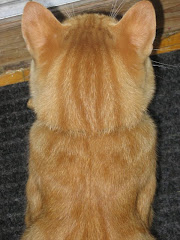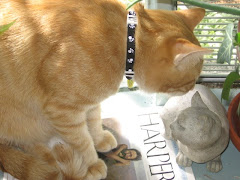
"And we praise You, my Lord,
for our Sister Earth,
who sustains us with her fruits,
and colored flowers, and herbs!"
for our Sister Earth,
who sustains us with her fruits,
and colored flowers, and herbs!"
From the Canticle of the Saint Francis of Assisi (Giovanni Bernardone, 1181-1226) Founder of the Order of Friars Minor, Patron saint of animals, zoos, ecologists, and environmentalists
Story and Photos by: FÜSUN ATALAY ~ Copyright © 2007
I've known for a long time that capers came in small jars in brine, but I never questioned where they originated or how they got there— until I visited the Mediterranean coast of Turkey some years ago where I saw young boys along the roadside selling small baskets of green, pea-sized berries they called ‘kebere’.
I don’t know if it was the adolescent voices of those young boys eager to sell the fruits of their early morning forays into the perilous habitats of caper bushes, or the tiny, dull, green berries which I couldn’t identify as anything I’d seen before that fascinated me and aroused my curiosity.
In any case, it took a little investigation before I could make the connection between those freshly picked ‘kebere’ and the caper berries I know, pickled in brine. Ever since, however, I’ve been intrigued by these olive-green flower buds of a hardy, perennial Mediterranean bush (Capparis spinosa) that contribute to the culinary cultures of the world.
As a naturally propagated wild bush, the caper plant is not fussy about its environment and thrives in dry earth, sending roots up to 40 meters deep into rocky crevices and arid hillsides exposed to the intense July and August sun.
The flower buds are picked before they start opening—a very labour intensive, daily task. This is a job best done by young, small hands because, as innocuous as they may seem, the buds of the thorny plant are not easy to harvest. After harvesting capers are sun-dried and pickled during July and August, when the sun is at its hottest along the Mediterranean coast.
Capers are preserved in brine or vinegar, or packed in sea salt (other kind of salts may cause early deterioration of the berries) after which their shelf life becomes practically indefinite. They range in size from the tiny (French) 'nonpareils' -most sought after for their pronounced taste and delicate texture- to those as large as cocktail olives. Perhaps because of their longevity after pickling, as well as their ability to complement many native Mediterranean herbs such as basil, oregano and tarragon, capers are one of the most versatile condiments and garnish ingredients.
French, Italian, Spanish and Turkish cuisines use capers to enhance the flavours of tomato and wine sauces, mayonnaise dressings; to add a pleasant piquancy to anchovies, poultry, fish and meat dishes or spice up appetizers, egg, potato and seafood salads.
Pickled capers are found in small glass jars among olives, pickles and other condiments on the supermarket shelves. They are commonly packed in brine; however they can be also salted and sold in bulk. In the latter case rinse the excess salt before using the berries. If you are buying pickled capers, look for bottles with no sediment, and once you open the bottle refrigerate the unused portion.
It’s ironic that my chance encounter with the young ‘kebere’ pickers on the sultry hillsides of the Turkish Mediterranean coast taught me more about capers. So it seems only fitting to end with a final word of advice I received from these amazingly knowledgeable, enthusiastic youngsters : If your recipe calls for capers in a cooked sauce, add them during the last few minutes of cooking to retain their intricate flavours and aroma.
Here are two delicious recipes which use capers as an essential ingredient.
Halibut with Caper-Lemon-Butter Sauce Serves 8
8 halibut steaks,
Sea salt
freshly ground black pepper
1/2 cup all-purpose flour
4 Tbsp olive oil
3 shallots, chopped
4 Tbsp capers in brine, drained
freshly squeezed juice of half a lemon
1 Tbsp lemon zest, finely grated
4 Tbsp butter
1/4 cup flat-leaf (Italian) parsley, chopped
Season halibut with salt and pepper on both sides. Place 2 Tbsp oil in a large non-stick skillet over medium-high heat.
Coat four fish steaks with flour and place in hot skillet. Cook, turning once, until fish is opaque and edges golden brown, (2 to 3 minutes). Transfer to a plate and keep warm. Add more oil to skillet, if necessary, and cook remaining floured halibut pieces.
When fish is cooked lower heat to medium, add remaining oil, shallots and capers to skillet. Sauté until shallots are light golden. Add lemon juice and zest, and bring to a boil. Simmer for one minute; add a pinch of salt and pepper. Remove from heat; whisk in butter and stir in parsley. Spoon over fish and garnish with slices of the remaining lemon half. Serve with oven roasted potato and fennel slices.
Pasta Puttanesca Serves 4
Quick, easy and tasty this dish is said to have originated in Naples after the local ladies of the night. Although spaghetti or linguine is the traditional, choice you can use any type of pasta on hand.
28 oz can Italian tomatoes
1/4 cup olive oil
3 garlic cloves, chopped
1 Tbsp fresh rosemary leaves, finely chopped
1 tsp dried chilli flakes
2 Tbsp capers, drained
1/4 cup pitted black olives, roughly chopped
6 anchovy fillets in oil, drained and chopped
1 Tbsp fresh oregano
1 lb spaghetti or linguini
1/3 cup Italian parsley, chopped
1/2 cup fresh basil leaves, torn to bite-size pieces
salt and pepper, to taste
Roughly chop tomatoes ; set aside.
Boil pasta in lots of salted water
Heat oil in a pan with the garlic and rosemary, simmer gently for about a minute.
Add the chilli, anchovies, tomatoes, olives, oregano, and black pepper. Simmer 10 minutes. Add the capers and continue to simmer for 1-2 minutes more.
Meanwhile, cook pasta in boiling water to al dente, approximately 7-8 minutes.
Drain pasta ; transfer into a large serving bowl and pour the sauce over. Sprinkle chopped parsley and toss together. Serve immediately.








































